Spatiotemporal Analysis of the Coupling Relationship between Habitat Quality and Urbanization in the Lower Yellow River
Abstract
1. Introduction
2. Data Material Sources and Research Methods
2.1. Definition of the Study Area
2.2. Data Sources and Processing
2.3. Methods
2.3.1. Evaluation of Habitat Quality
2.3.2. Evaluation of Urbanization
2.3.3. Coupling Coordination Degree Model
3. Results
3.1. Variations in Habitat Quality through Time and Space along the Lower Yellow River
3.2. Variations in Urbanization through Time and Space along the Lower Yellow River
3.3. Coupling Coordination Relationship between Urbanization and Habitat Quality in the Lower Yellow River
4. Discussion
5. Conclusions
Author Contributions
Funding
Institutional Review Board Statement
Informed Consent Statement
Data Availability Statement
Conflicts of Interest
References
- Johnson, M.D. Measuring Habitat Quality: A Review. Condor 2007, 109, 489–504. [Google Scholar] [CrossRef]
- Zhang, H.; Zhang, C.; Hu, T.; Zhang, M.; Ren, X.; Hou, L. Exploration of roadway factors and habitat quality using InVEST. Transp. Res. Part D Transp. Environ. 2020, 87, 102551. [Google Scholar] [CrossRef]
- Gao, Y.; Ma, L.; Liu, J.; Zhuang, Z.; Huang, Q.; Li, M. Constructing Ecological Networks Based on Habitat Quality Assessment: A Case Study of Changzhou, China. Sci. Rep. 2017, 7, 46073. [Google Scholar] [CrossRef]
- Zhang, Y.; Chen, R.; Wang, Y. Tendency of land reclamation in coastal areas of Shanghai from 1998 to 2015. Land Use Policy 2020, 91, 104370. [Google Scholar] [CrossRef]
- Horcajada-Sanchez, F.; Escribano-Avila, G.; Lara-Romero, C.; Virgos, E.; Barja, I. The effect of livestock on the physiological condition of roe deer (Capreolus capreolus) is modulated by habitat quality. Sci. Rep. 2019, 9, 15953. [Google Scholar] [CrossRef]
- Fu, B. The evaluation of eco-environmental qualities in China. China Popul. Resour. Environ. 1992, 02, 48–54. [Google Scholar]
- Zhang, X.; Liao, L.; Xu, Z.; Zhang, J.; Chi, M.; Lan, S.; Gan, Q. Interactive Effects on Habitat Quality Using InVEST and GeoDetector Models in Wenzhou, China. Land 2022, 11, 630. [Google Scholar] [CrossRef]
- Berta Aneseyee, A.; Noszczyk, T.; Soromessa, T.; Elias, E. The InVEST Habitat Quality Model Associated with Land Use/Cover Changes: A Qualitative Case Study of the Winike Watershed in the Omo-Gibe Basin, Southwest Ethiopia. Remote Sens. 2020, 12, 1103. [Google Scholar] [CrossRef]
- Li, M.; Zhou, Y.; Xiao, P.; Tian, Y.; Huang, H.; Xiao, L. Evolution of Habitat Quality and Its Topographic Gradient Effect in Northwest Hubei Province from 2000 to 2020 Based on the InVEST Model. Land 2021, 10, 857. [Google Scholar] [CrossRef]
- Wu, J.; Li, X.; Luo, Y.; Zhang, D. Spatiotemporal effects of urban sprawl on habitat quality in the Pearl River Delta from 1990 to 2018. Sci. Rep. 2021, 11, 13981. [Google Scholar] [CrossRef]
- Chen, T.-Y.; Hwang, G.-W.; Mayfield, A.B.; Chen, C.-P.; Lin, H.-J. The development of habitat suitability models for fiddler crabs residing in subtropical tidal flats. Ocean Coast. Manag. 2019, 182, 104931. [Google Scholar] [CrossRef]
- Zhang, Z.; Zhang, H.; Feng, J.; Wang, Y.; Liu, K. Evaluation of Social Values for Ecosystem Services in Urban Riverfront Space Based on the SolVES Model: A Case Study of the Fenghe River, Xi’an, China. Int. J. Environ. Res. Public Health 2021, 18, 2765. [Google Scholar] [CrossRef] [PubMed]
- Sherrouse, B.C.; Semmens, D.J.; Ancona, Z.H. Social Values for Ecosystem Services (SolVES): Open-source spatial modeling of cultural services. Environ. Model. Softw. 2022, 148, 105259. [Google Scholar] [CrossRef]
- Wu, J.; Luo, J.; Zhang, H.; Qin, S.; Yu, M. Projections of land use change and habitat quality assessment by coupling climate change and development patterns. Sci. Total Environ. 2022, 847, 157491. [Google Scholar] [CrossRef]
- Sun, X.; Jiang, Z.; Liu, F.; Zhang, D. Monitoring spatio-temporal dynamics of habitat quality in Nansihu Lake basin, eastern China, from 1980 to 2015. Ecol. Indic. 2019, 102, 716–723. [Google Scholar] [CrossRef]
- Lin, Y.-P.; Lin, W.-C.; Wang, Y.-C.; Lien, W.-Y.; Huang, T.; Hsu, C.-C.; Schmeller, D.S.; Crossman, N.D. Systematically designating conservation areas for protecting habitat quality and multiple ecosystem services. Environ. Model. Softw. 2017, 90, 126–146. [Google Scholar] [CrossRef]
- Wei, H.; Xiong, L.; Tang, G.; Strobl, J.; Xue, K. Spatial–temporal variation of land use and land cover change in the glacial affected area of the Tianshan Mountains. CATENA 2021, 202, 105256. [Google Scholar] [CrossRef]
- Kunwar, R.M.; Evans, A.; Mainali, J.; Ansari, A.S.; Rimal, B.; Bussmann, R.W. Change in forest and vegetation cover influencing distribution and uses of plants in the Kailash Sacred Landscape, Nepal. Environ. Dev. Sustain. 2018, 22, 1397–1412. [Google Scholar] [CrossRef]
- Wang, H.; He, Q.; Liu, X.; Zhuang, Y.; Hong, S. Global urbanization research from 1991 to 2009: A systematic research review. Landsc. Urban Plan. 2012, 104, 299–309. [Google Scholar] [CrossRef]
- Liu, X.; Wang, Y.; Li, Y.; Wu, J. Quantifying the Spatio-Temporal Process of Township Urbanization: A Large-Scale Data-Driven Approach. ISPRS Int. J. Geo-Inf. 2019, 8, 389. [Google Scholar] [CrossRef]
- Zhang, D.; Xu, J.; Zhang, Y.; Wang, J.; He, S.; Zhou, X. Study on sustainable urbanization literature based on Web of Science, scopus, and China national knowledge infrastructure: A scientometric analysis in CiteSpace. J. Clean. Prod. 2020, 264, 121537. [Google Scholar] [CrossRef]
- Zhang, Q.-R.; Li, Y.; Liu, J.-S.; Chen, Y.-D.; Chai, L.-H. A dynamic co-word network-related approach on the evolution of China’s urbanization research. Scientometrics 2017, 111, 1623–1642. [Google Scholar] [CrossRef]
- Jiao, H.; Zhang, X.; Yang, C.; Cao, X. The characteristics of spatial expansion and driving forces of land urbanization in counties in central China: A case study of Feixi county in Hefei city. PLoS ONE 2021, 16, e0252331. [Google Scholar] [CrossRef]
- Yu, M.; Guo, S.; Guan, Y.; Cai, D.; Zhang, C.; Fraedrich, K.; Liao, Z.; Zhang, X.; Tian, Z. Spatiotemporal heterogeneity analysis of Yangtze River delta urban agglomeration: Evidence from nighttime light data (2001–2019). Remote Sens. 2021, 13, 1235. [Google Scholar] [CrossRef]
- Chu, N.; Zhang, P.; Wu, X. Spatiotemporal evolution characteristics of urbanization and its coupling coordination degree in Russia—Perspectives from the population, economy, society, and eco-environment. Environ. Sci. Pollut. Res. 2022, 29, 61334–61351. [Google Scholar] [CrossRef] [PubMed]
- Duha, J.; Shandas, V.; Chang, H.; George, L.A. Rates of urbanisation and the resiliency of air and water quality. Sci. Total Environ. 2008, 400, 238–256. [Google Scholar] [CrossRef] [PubMed]
- Liu, H.; Fang, C.; Li, Y. The Coupled Human and Natural Cube: A conceptual framework for analyzing urbanization and eco-environment interactions. Acta Geogr. Sin. 2019, 74, 1489–1507. [Google Scholar]
- Xiao, R.; Lin, M.; Fei, X.; Li, Y.; Zhang, Z.; Meng, Q. Exploring the interactive coercing relationship between urbanization and ecosystem service value in the Shanghai–Hangzhou Bay Metropolitan Region. J. Clean. Prod. 2020, 253, 119803. [Google Scholar] [CrossRef]
- Zhu, C.; Zhang, X.; Zhou, M.; He, S.; Gan, M.; Yang, L.; Wang, K. Impacts of urbanization and landscape pattern on habitat quality using OLS and GWR models in Hangzhou, China. Ecol. Indic. 2020, 117, 106654. [Google Scholar] [CrossRef]
- Yohannes, H.; Soromessa, T.; Argaw, M.; Dewan, A. Spatio-temporal changes in habitat quality and linkage with landscape characteristics in the Beressa watershed, Blue Nile basin of Ethiopian highlands. J. Environ. Manag. 2021, 281, 111885. [Google Scholar] [CrossRef]
- Yushang, c.; Yang, G.; Zhen, X.; Yuzhu, Z.; Xize, Y. Spatiotemporal evolution and spatial correlation of habitat quality and landscape pattern over Beijing-Tianjin-Hebei region. China Environ. Sci. 2021, 41, 848–859. [Google Scholar]
- Xiaonan, W.; Wei, S. Transformation efficiency of resource-based cities in the Yellow River Basin and its influencing factors. Prog. Geogr. 2020, 39, 1643–1655. [Google Scholar]
- Zhang, X.; Lyu, C.; Fan, X.; Bi, R.; Xia, L.; Xu, C.; Sun, B.; Li, T.; Jiang, C. Spatiotemporal Variation and Influence Factors of Habitat Quality in Loess Hilly and Gully Area of Yellow River Basin: A Case Study of Liulin County, China. Land 2022, 11, 127. [Google Scholar] [CrossRef]
- Li, L.; Xu, W.; Zheng, J. A Study on Spatial lnteractive Effects Between Urbanization Process and Ecological Efficiency in the Yellow River Basin. Econ. Surv. 2022, 39, 25–34. [Google Scholar]
- He, H.; Wang, Z.; Dong, J.; Wang, J.; Zou, J. Synergy and trade-off between vegetation change and urbanization development in the YellowRiver Basin of Shaanxi Province based on satellite remote sensing data. Acta Ecol. Sin. 2022, 42, 3536–3545. [Google Scholar]
- Zhao, J.; Zhao, H. Coupling coordination analysis of urbanization and eco-environment in Ningxia based onDMSP-OLS and MODIS data. Bull. Surv. Mapp. 2021, 535, 9. [Google Scholar]
- Li, Y.; Dan, X. Spatiotemporal change of urban green development efficiency in the Yellow River Basin and influencing factors. Resour. Sci. 2020, 42, 2274–2284. [Google Scholar]
- Keyun, Z.; Ying, Z. The Evolution of Regional Economic Disparity in the Yellow River Basin at Different Spatial Scales. Econ. Geogr. 2020, 40, 1–11. [Google Scholar]
- Tang, F.; Fu, M.; Wang, L.; Zhang, P. Land-use change in Changli County, China: Predicting its spatio-temporal evolution in habitat quality. Ecol. Indic. 2020, 117, 106719. [Google Scholar] [CrossRef]
- Li, Y.; Duo, L.; Zhang, M.; Yang, J.; Guo, X. Habitat quality assessment of mining cities based on InVEST model—A case study of Yanshan County, Jiangxi Province. Int. J. Coal Sci. Technol. 2022, 9, 28. [Google Scholar] [CrossRef]
- Hu, B.; Kang, F.; Han, H.; Cheng, X.; Li, Z. Exploring drivers of ecosystem services variation from a geospatial perspective: Insights from China’s Shanxi Province. Ecol. Indic. 2021, 131, 108188. [Google Scholar] [CrossRef]
- Li, X.; Liu, Z.; Li, S.; Li, Y. Multi-Scenario Simulation Analysis of Land Use Impacts on Habitat Quality in Tianjin Based on the PLUS Model Coupled with the InVEST Model. Sustainability 2022, 14, 6923. [Google Scholar] [CrossRef]
- Tian, Y.; Huang, P.; Zhao, X. Spatial analysis, coupling coordination, and efficiency evaluation of green innovation: A case study of the Yangtze River Economic Belt. PLoS ONE 2020, 15, 243459. [Google Scholar] [CrossRef]
- Wang, D.; Jiang, D.; Fu, J.; Lin, G.; Zhang, J. Comprehensive Assessment of Production–Living–Ecological Space Based on the Coupling Coordination Degree Model. Sustainability 2020, 12, 2009. [Google Scholar] [CrossRef]
- Ma, M.; Tang, J. Interactive coercive relationship and spatio-temporal coupling coordination degree between tourism urbanization and eco-environment: A case study in Western China. Ecol. Indic. 2022, 142, 109149. [Google Scholar] [CrossRef]
- Tang, F.; Wang, L.; Guo, Y.; Fu, M.; Huang, N.; Duan, W.; Luo, M.; Zhang, J.; Li, W.; Song, W. Spatio-temporal variation and coupling coordination relationship between urbanisation and habitat quality in the Grand Canal, China. Land Use Policy 2022, 117, 106119. [Google Scholar] [CrossRef]
- Liang, Z.; Jianjun, T.; Xingke, L.; Xuewei, D.; Haowei, M. Effects of urban expansion on habitat quality in densely populated areas on the Loess Pla-teau: A case study of Lanzhou, Xi’an-Xianyang and Taiyuan, China. Chin. J. Appl. Ecol. 2021, 32, 261–270. [Google Scholar]
- Lin, C.; Chong, H.; Qingsheng, L.; Gaohuan, L. Changes of coastal zone landscape spatial patterns and ecological quality in Liaoning Province from 2000 to 2010. Resour. Sci. 2015, 37, 1962–1972. [Google Scholar]
- Tang, Y.; Gao, C.; Wu, X. Urban Ecological Corridor Network Construction: An Integration of the Least Cost Path Model and the InVEST Model. ISPRS Int. J. Geo-Inf. 2020, 9, 33. [Google Scholar] [CrossRef]
- Zhang, T.; Gao, Y.; Li, C.; Xie, Z.; Chang, Y.; Zhang, B. How Human Activity Has Changed the Regional Habitat Quality in an Eco-Economic Zone: Evidence from Poyang Lake Eco-Economic Zone, China. Int. J. Environ. Res. Public Health 2020, 17, 6253. [Google Scholar] [CrossRef]
- Wu, L.; Sun, C.; Fan, F. Estimating the Characteristic Spatiotemporal Variation in Habitat Quality Using the InVEST Model—A Case Study from Guangdong–Hong Kong–Macao Greater Bay Area. Remote Sens. 2021, 13, 1008. [Google Scholar] [CrossRef]
- Fan, X.; Gu, X.; Yu, H.; Long, A.; Tiando, D.S.; Ou, S.; Li, J.; Rong, Y.; Tang, G.; Zheng, Y.; et al. The Spatial and Temporal Evolution and Drivers of Habitat Quality in the Hung River Valley. Land 2021, 10, 1369. [Google Scholar] [CrossRef]
- Yun, X. Coupling Coordination Measurement and Interactive Coercing Verification Between Urbanization and Eco-Environment in the Yellow River Basin. Econ. Probl. 2022, 516, 86–95. [Google Scholar]

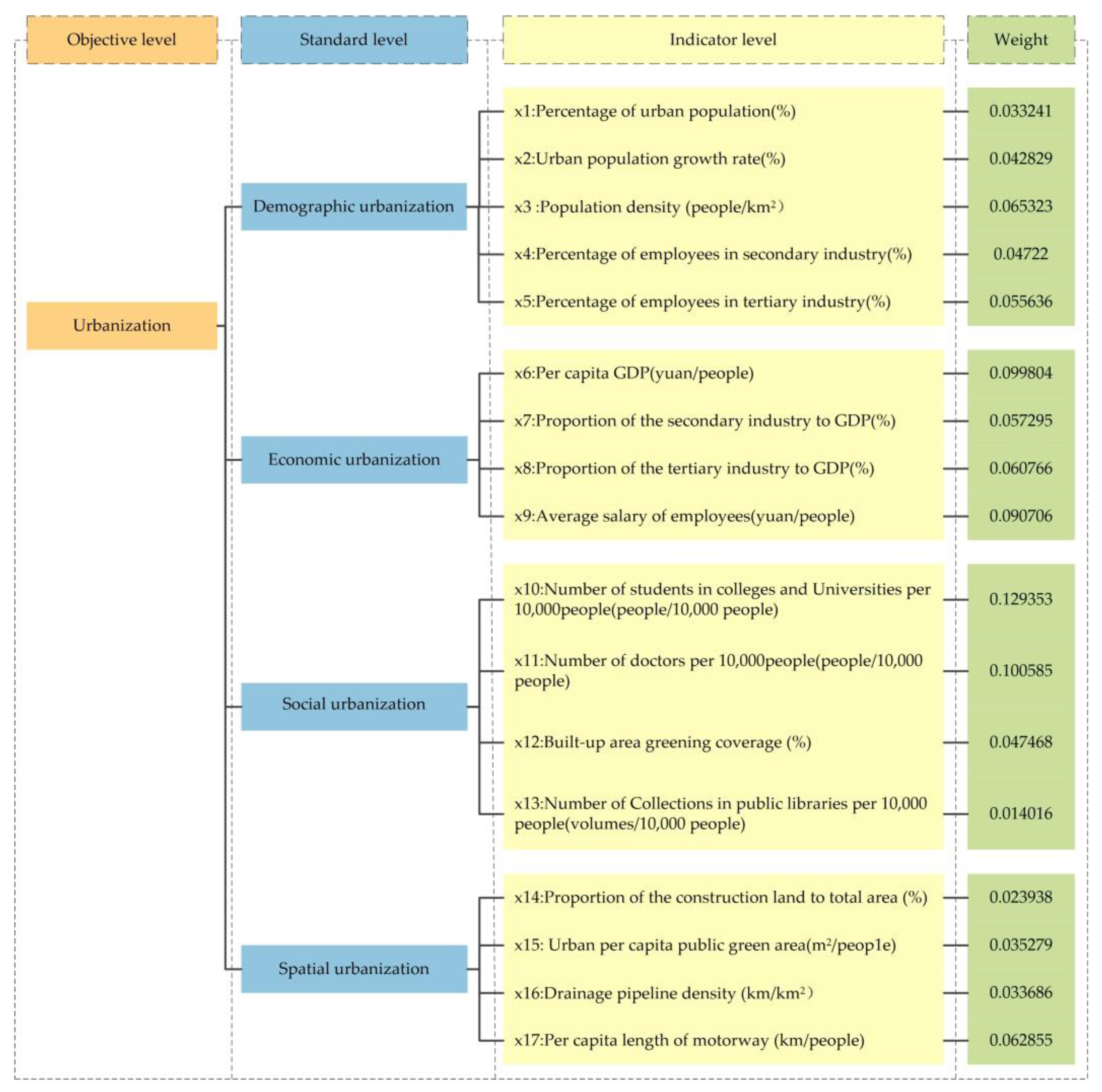
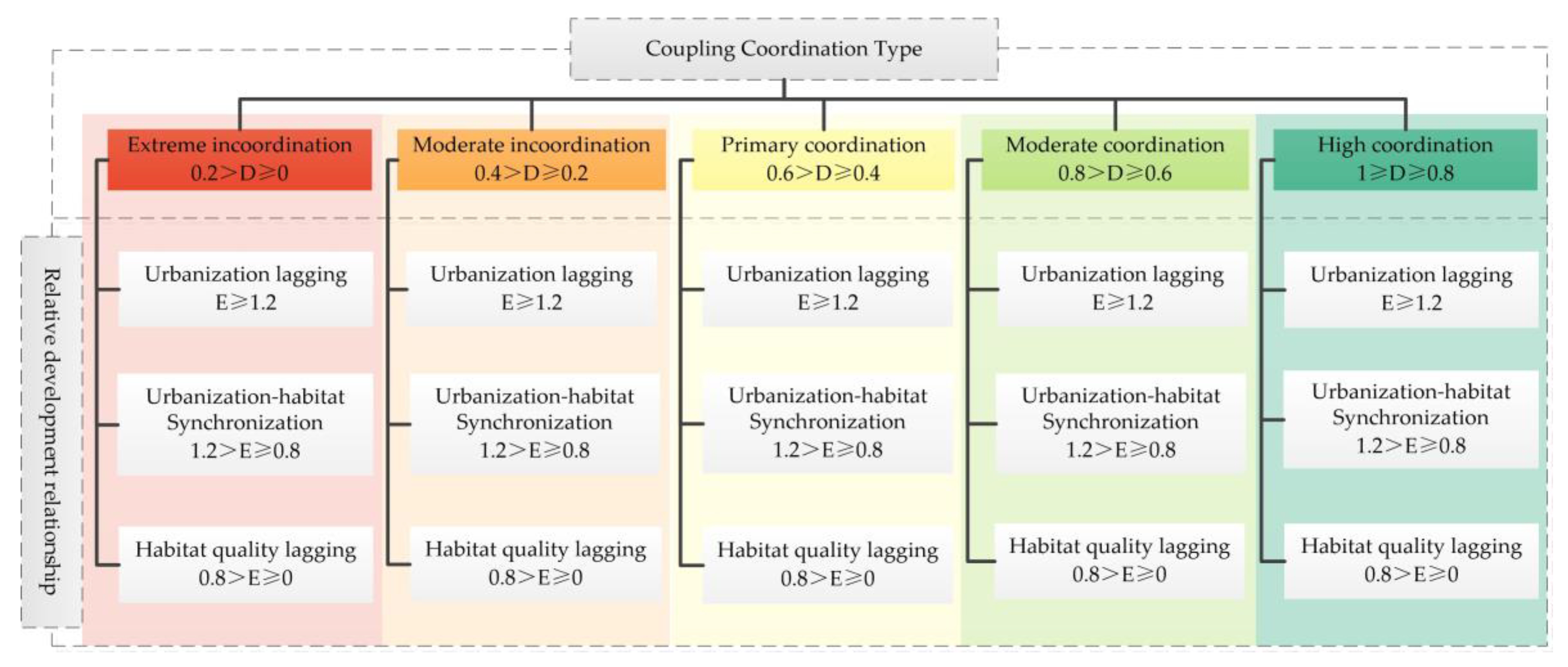
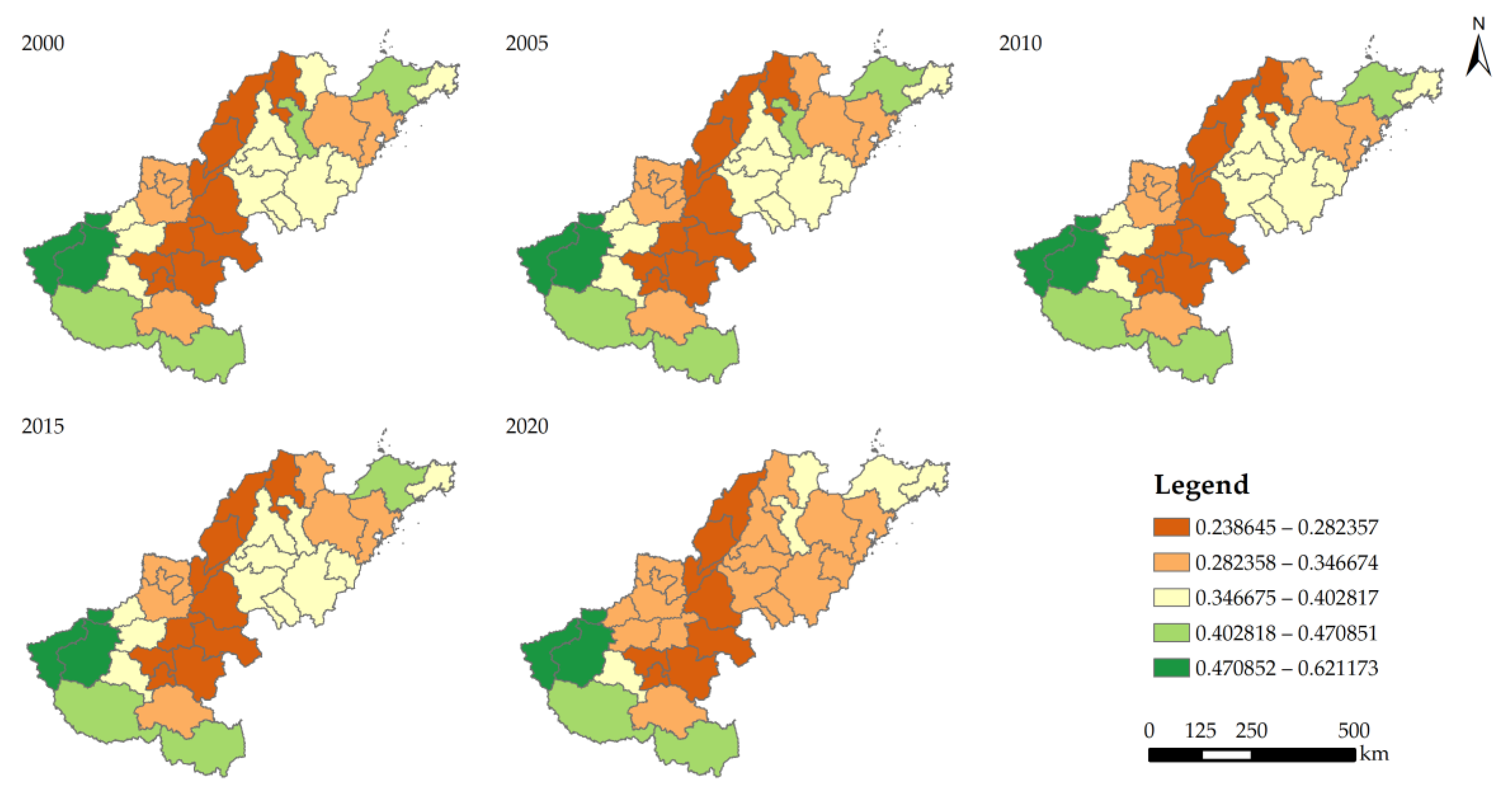

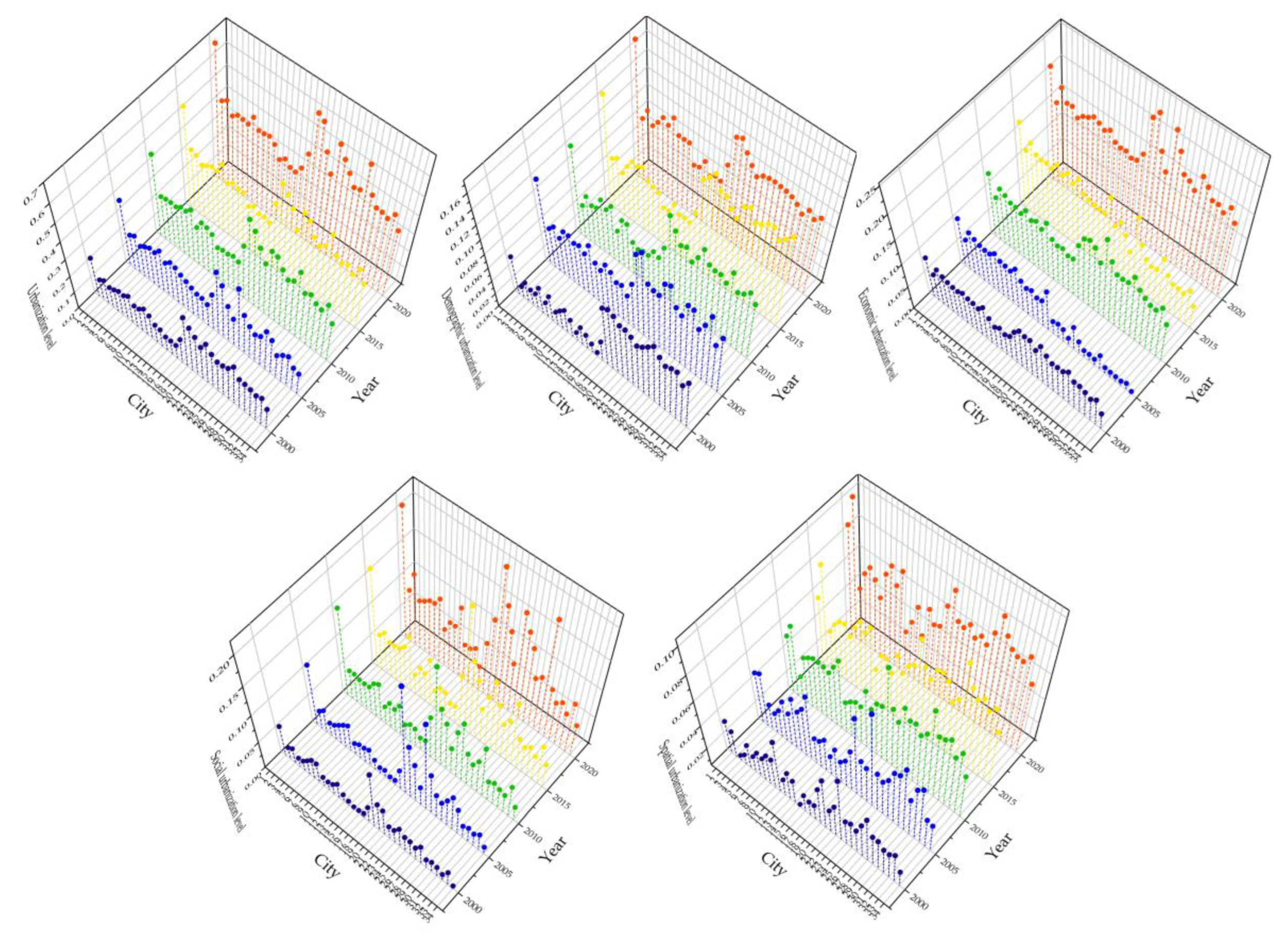
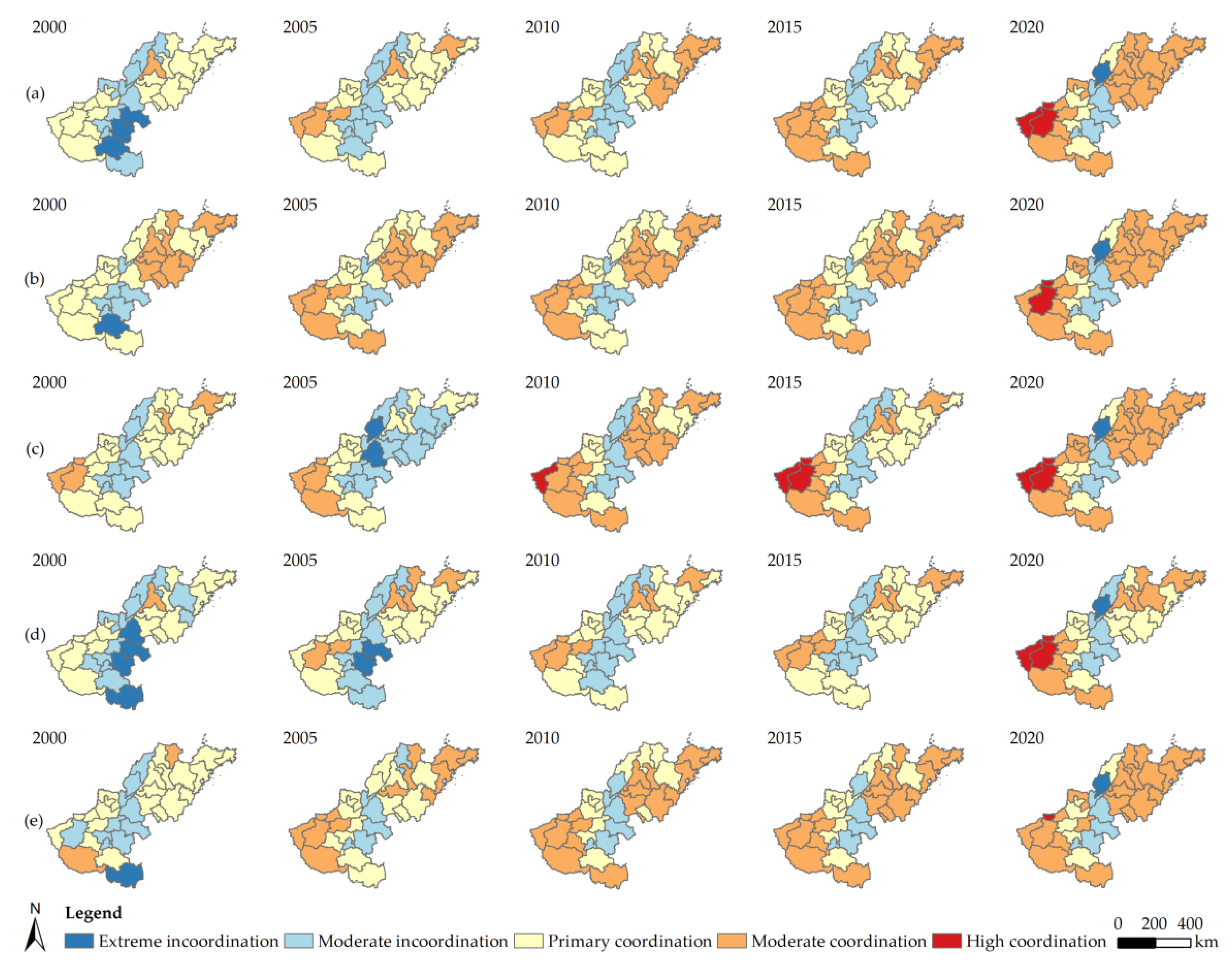
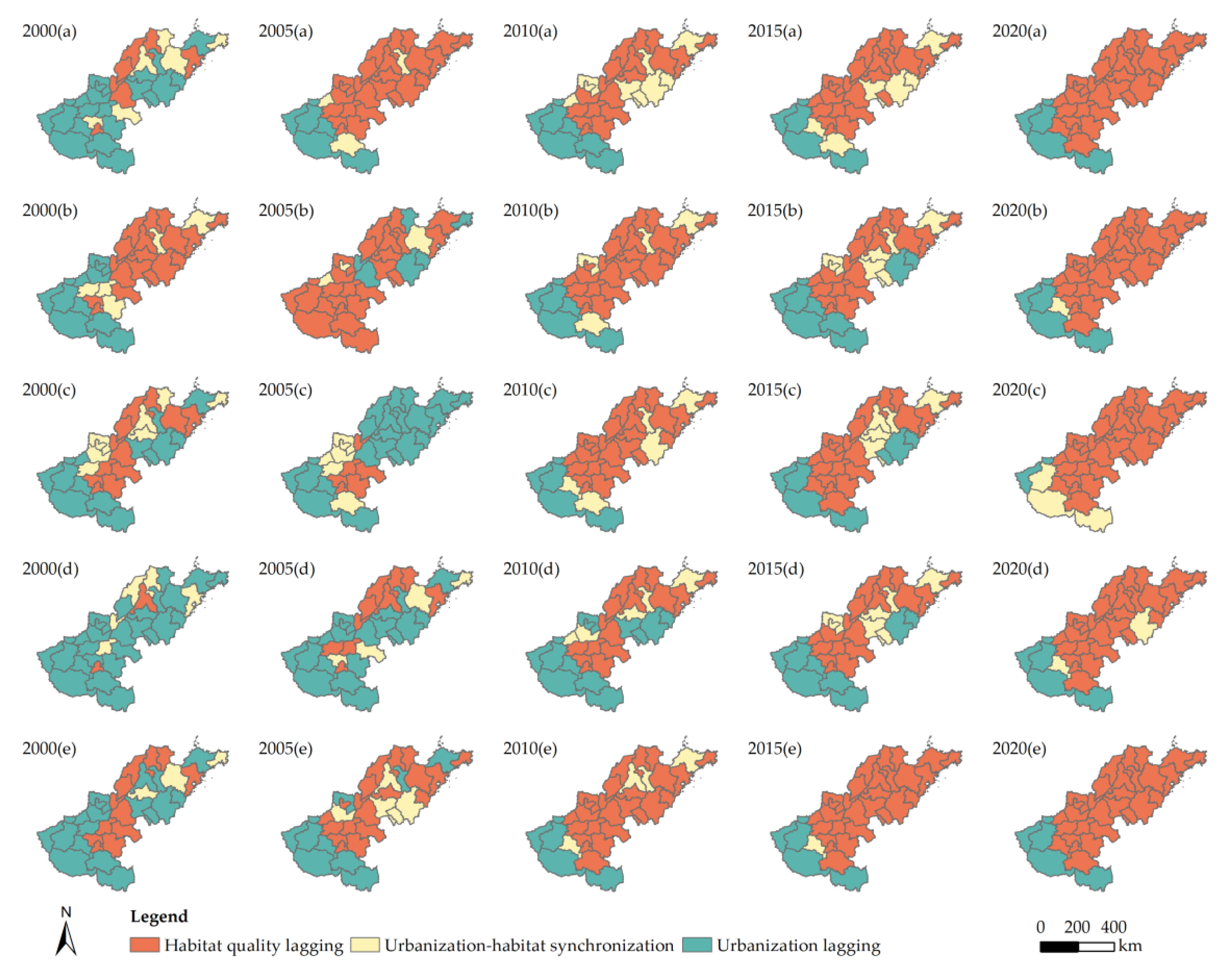
| Threat Source (r) | Maximum Threat Distance (drmax)/km | Weight (wr) | Decay |
|---|---|---|---|
| Paddy field | 1 | 0.5 | linear |
| Dry land | 1 | 0.5 | linear |
| Urban construction land | 8 | 1 | exponential |
| Rural residential land | 4 | 0.7 | exponential |
| Other construction land | 9 | 0.9 | exponential |
| Other unutilized land | 1 | 0.3 | linear |
| Land Type (j) | Habitat Suitability (Hj) | Sensitivity (Sjr) | |||||
|---|---|---|---|---|---|---|---|
| Paddy Field | Dry Land | Urban Construction Land | Rural Residential Land | Other Construction Land | Other Unutilized Land | ||
| Paddy field | 0.4 | 0 | 0.7 | 0.3 | 0 | 0 | 0.7 |
| Dry land | 0.3 | 0 | 0.6 | 0.2 | 0 | 0 | 0.6 |
| Forest land | 0.9 | 0.6 | 0.9 | 0.5 | 0.6 | 0.6 | 0.85 |
| Scrub woodland | 0.8 | 0.5 | 0.85 | 0.45 | 0.5 | 0.5 | 0.75 |
| Sparse woodland | 0.75 | 0.5 | 0.85 | 0.45 | 0.5 | 0.5 | 0.75 |
| Other woodland | 0.65 | 0.45 | 0.85 | 0.4 | 0.45 | 0.45 | 0.7 |
| High-coverage grassland | 0.7 | 0.55 | 0.9 | 0.5 | 0.55 | 0.55 | 0.85 |
| Medium-coverage grassland | 0.6 | 0.5 | 0.85 | 0.45 | 0.5 | 0.5 | 0.75 |
| Low-coverage grassland | 0.55 | 0.45 | 0.8 | 0.4 | 0.45 | 0.45 | 0.75 |
| River | 0.9 | 0.6 | 0.9 | 0.5 | 0.6 | 0.6 | 0.85 |
| Lake | 1 | 0.6 | 0.9 | 0.5 | 0.6 | 0.6 | 0.85 |
| Reservoir | 0.7 | 0.55 | 0.8 | 0.45 | 0.55 | 0.55 | 0.75 |
| Mudflat | 0.5 | 0.4 | 0.75 | 0.4 | 0.4 | 0.4 | 0.7 |
| Beach | 0.5 | 0.4 | 0.75 | 0.4 | 0.4 | 0.4 | 0.7 |
| Swamp | 0.55 | 0.45 | 0.8 | 0.4 | 0.45 | 0.45 | 0.7 |
| Sea | 0.85 | 0.6 | 0.6 | 0.85 | 0.7 | 0.9 | 0.5 |
| Other unutilized land | 0.15 | 0.35 | 0.35 | 0.55 | 0.4 | 0.55 | 0 |
Disclaimer/Publisher’s Note: The statements, opinions and data contained in all publications are solely those of the individual author(s) and contributor(s) and not of MDPI and/or the editor(s). MDPI and/or the editor(s) disclaim responsibility for any injury to people or property resulting from any ideas, methods, instructions or products referred to in the content. |
© 2023 by the authors. Licensee MDPI, Basel, Switzerland. This article is an open access article distributed under the terms and conditions of the Creative Commons Attribution (CC BY) license (https://creativecommons.org/licenses/by/4.0/).
Share and Cite
Sun, J.; Han, M.; Kong, F.; Wei, F.; Kong, X. Spatiotemporal Analysis of the Coupling Relationship between Habitat Quality and Urbanization in the Lower Yellow River. Int. J. Environ. Res. Public Health 2023, 20, 4734. https://doi.org/10.3390/ijerph20064734
Sun J, Han M, Kong F, Wei F, Kong X. Spatiotemporal Analysis of the Coupling Relationship between Habitat Quality and Urbanization in the Lower Yellow River. International Journal of Environmental Research and Public Health. 2023; 20(6):4734. https://doi.org/10.3390/ijerph20064734
Chicago/Turabian StyleSun, Jinxin, Mei Han, Fanbiao Kong, Fan Wei, and Xianglun Kong. 2023. "Spatiotemporal Analysis of the Coupling Relationship between Habitat Quality and Urbanization in the Lower Yellow River" International Journal of Environmental Research and Public Health 20, no. 6: 4734. https://doi.org/10.3390/ijerph20064734
APA StyleSun, J., Han, M., Kong, F., Wei, F., & Kong, X. (2023). Spatiotemporal Analysis of the Coupling Relationship between Habitat Quality and Urbanization in the Lower Yellow River. International Journal of Environmental Research and Public Health, 20(6), 4734. https://doi.org/10.3390/ijerph20064734







